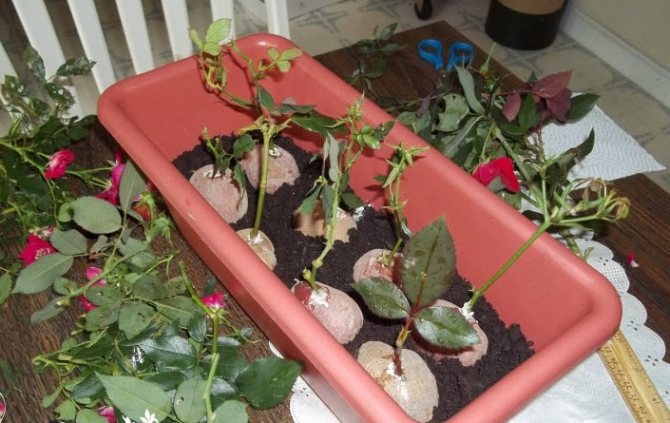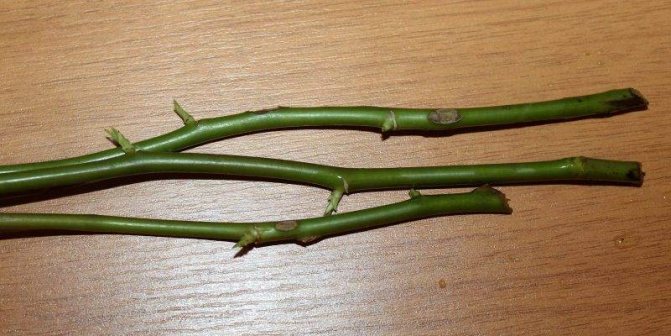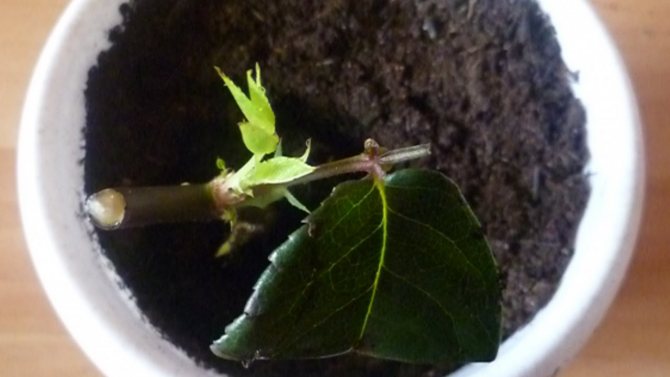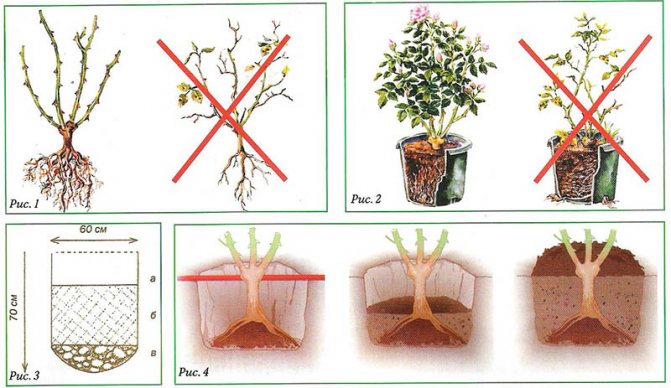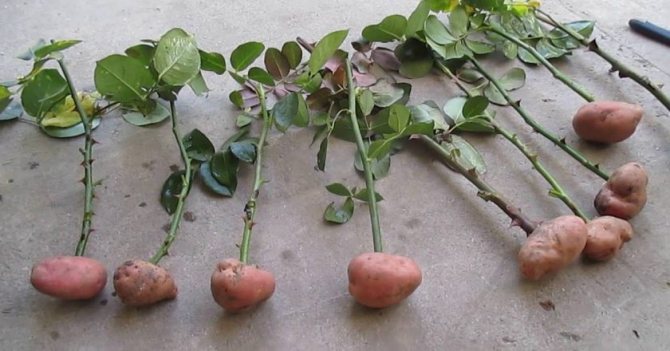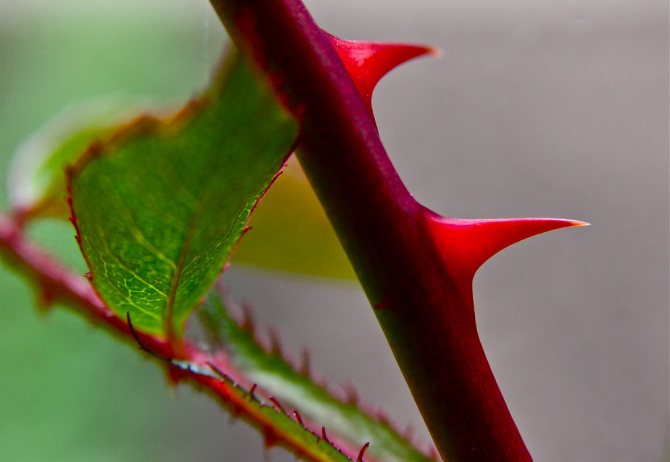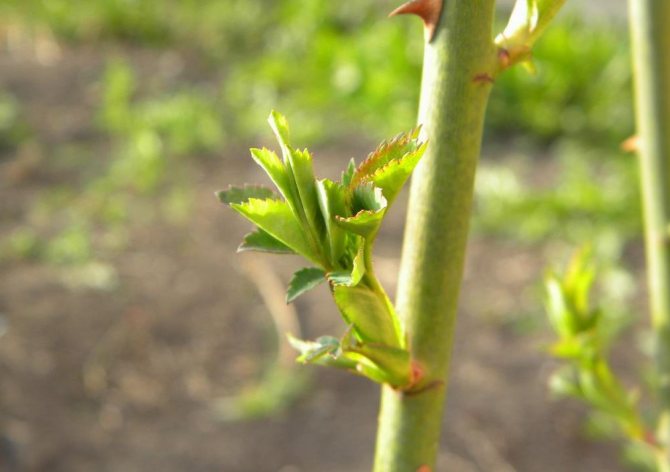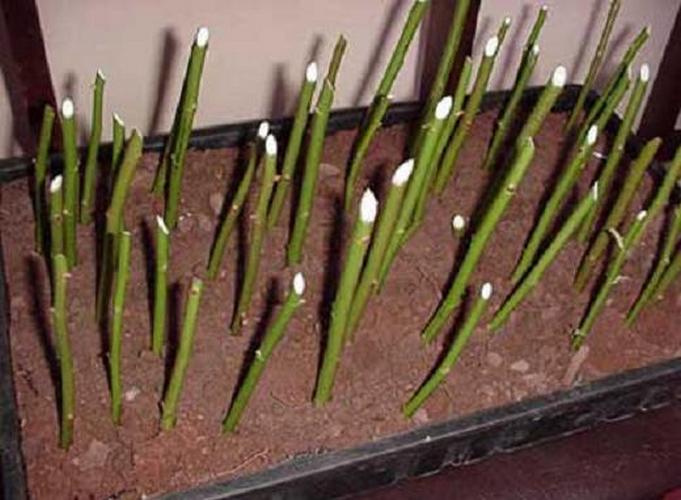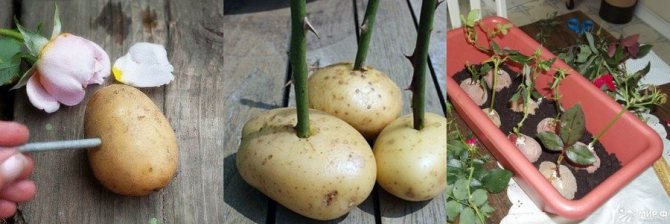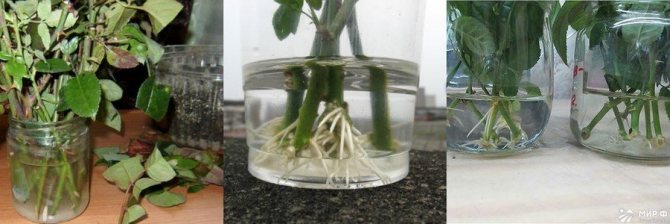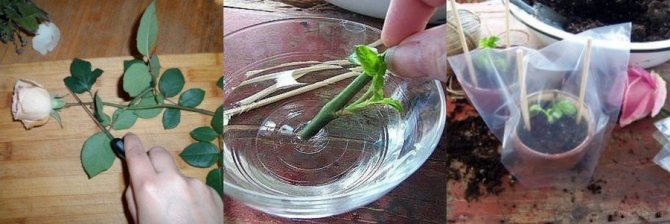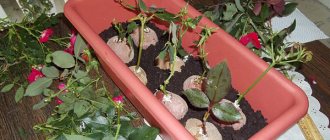
Presents
- When and how best to cut roses?
- Growth promoters: how to soak cuttings?
- How to grow a rose in water?
- The presented rose gave a sprout: a sign
You were presented with a magnificent bouquet of roses, and looking at it, you know for sure that in a couple of days (maximum weeks) it will simply wither. But what kind of roses
! Eye-catching! There is an easy way to revive this unearthly beauty - to grow roses from cuttings of donated roses. The option is tempting, but the growing process will require some knowledge and skills from you.


Bouquet of roses
Benefits of growing roses from a bouquet
The advantages of growing roses, the seedlings of which are grown at home, over shop bushes include:
- there is a high probability that the store bush will not take root on the site. Store seedlings are grown in special conditions: a special soil composition, various chemical stimulants and top dressing are used. On the site, the plant loses all this, and therefore, it begins to hurt;
- exactly the kind of rose that you want will grow on the site;
- Growing roses yourself is much more economical.
Which rose to choose?
It is best to choose a domestic flower for growing a rose from a cutting; foreign ones should be discarded.
Roses from other countries are often treated with means that kind of freeze them. This is bad and the rose may not grow.
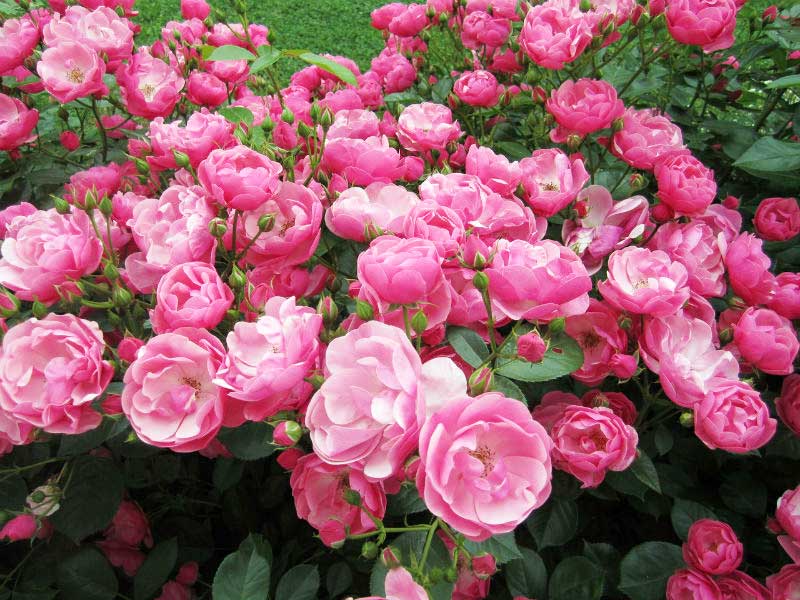

Also, pay attention that there are 2-3 buds on one cuttings that you plucked. It is important!
The stalk should not be thick or thin.
What to do if the rose has sprouted or leaves
The rose in the vase gave new leaves what to do? What should be done if the rose has sprouted in a vase? These questions arise if any new parts grow in the cut flower. If there are only leaves, it will not be possible to extend the life of the rose, but if roots appear, then you can try to transplant it into the soil. However, if the plant is imported, then it will not be able to take root, since it will not survive the winter.
Also, those flowers that stand for more than a month will not be able to take root, since they are treated with chemicals. The flower cannot grow without chemical feeding. Summer cuttings take root best of all.
Problems and difficulties
The roots of a rose grown in water have a completely different structure than those that emerged as a result of the rooting of a flower in the ground. Roots from the water are thinner, weaker, translucent, fragile and very susceptible to rot... They can be easily injured or even broken off when transplanted into the substrate. Therefore, when planting, you must be as careful as possible, otherwise the plant will have to go through the rooting process again, and this, as a rule, ends in failure.
The water contains an insufficient amount of oxygen, and therefore the following phenomenon can often be observed: the rose "grew" sufficiently strong roots in a vase, and when it was planted in the soil, it died, the adaptation process failed. This is the main disadvantage of rose propagation by rooting in water.
A rose sprouted in a vase can be planted both in a pot and in open ground. But it must be remembered that this breeding method is very unreliable. Therefore, do not despair if the attempt to grow a new bush is unsuccessful. Rose is a very moody flower.You should be patient and try your luck next time.
Best deadlines for work
In order for the process of cutting roses from a bouquet to bring the best results, all procedures are best carried out in late spring, summer, autumn. The best root growth occurs in June. August-September is the time when the strength of the flowers becomes less, which negatively affects the growth of the root system.
Rose in a vase gave leaves
At other times, the rooting process will go badly. The most unfavorable period is January-February. Most likely, the results of a novice grower at this time will be negative. In winter, it is necessary to provide flowers with optimal illumination, temperature, humidity.
The secret of success
The main problem, according to which the rooting of purchased roses is something from the realm of fantasy, is that only roses that were grown in Russian greenhouses are suitable for such a process. But as for imported roses, for example, as widespread and popular as the Dutch ones, you should not count on a good result. All this is explained very simply. The fact is that when sending roses from abroad, so that they do not deteriorate for a long time, the flowers are treated with special preparations. Ultimately, such roses, which can hardly be called alive, are unable to take root.
Ways to take a shoot from a rose
Before figuring out how to take a shoot from a rose, it is worth studying the rules for choosing it, according to which it will be more suitable for growing from scratch. Requirements:
- the flower must be fresh;
- for grafting, it is best to use the middle part of the stem;
- the rose must be of domestic production. Foreign flowers are treated with various chemicals. Because of this, the rose may not sprout;
- there should be 2-3 buds on one cutting;
- the stem of the rose should be thick, juicy and green;
- the buds should be fully ripe and not dark.
The shoot of a rose
A rose is not suitable for growing if:
- the flower has been cut for a long time and stands in a vase for a long time, since there are most likely harmful microorganisms in its stem;
- the stem of the flower is too thin or woody with a thick core;
- the stem turned dark in the water;
- cracks appeared on the stem;
- there is no skin on the stem in some places.
Important! You can't keep a rose for a long time in order to root it. Immediately after the flower is purchased, it must be planted.
Also, the stalk should be properly prepared:
- cut the cuttings from the stem, leave a length of 20-30 cm. Pruning is done with a sharp knife or pruner to prevent injury to the stem. Also, the tool must be pre-disinfected to exclude infection;
- remove the bottom leaves, thorns, buds, bad buds. The upper leaves are shortened by 1/3;
- the bottom is cut at a 45 degree angle and the top is straight. Everything is lubricated with wax. Slices must be done so that from vital buds to a cut is 1 cm;
- clean settled water is poured into the container. A root growth stimulator (Kornevin, Epin, Charkor) is diluted in water. The drugs are used in accordance with the instructions on the package. The cuttings are immersed in water for 1/3 for 6 hours. You can also make a homemade solution from a glass of water, twenty drops of aloe juice, or a teaspoon of honey. In this solution, the stems are soaked for a day.
There are three ways to plant a cut rose: growing in a flower pot, in potatoes, in water.
Growing in a pot
There are many recommendations on how to plant a rose shoot in a pot. With this method, the root system develops strong, resistant to adverse factors. A separate pot is prepared for each cutting. If all cuttings are planted in a common box, then there should be an interval of 6-8 cm between them.The flower container should have several holes. The soil should be especially for roses, soil is suitable for violets.
You can also mix two parts of garden soil, two parts of rotted compost, one part of washed sand. When moss is added to the ground, the likelihood of plant decay is reduced. Moss also allows air to pass through, which has a beneficial effect on rooting.
Detailed step-by-step potting:
- The container is treated with potassium permanganate and dried well.
- The bottom is laid out with drainage, then soil is poured, which is preheated in the oven.
- Each stalk is dipped in Kornevin, which will protect it from decay.
- Then the cuttings are planted in the ground by 2-3 cm. Two buds are left on top.
- Moisturize the soil.
- Dry soil is poured on top to prevent crust formation.
- A plastic bottle is used for shelter, which will create a greenhouse effect. The boxes are covered with foil. It is necessary to maintain the temperature during the day +25 degrees, at night +18 degrees.
- The container is exposed in a place not too sunlit and not heavily blown by drafts.
- Sometimes it is worth adding water, but not too much.
- After the first leaves appear, the jar can be removed.
Growing in a pot
With this method, the roots should germinate after about 30 days.
Growing with potatoes
This method has appeared recently. However, the results are quite productive. Potatoes have the necessary nutrients and moisture for the cuttings. Only young potatoes are suitable. Before planting a cutting in a potato, the tuber should be prepared. To do this, it is washed, the eyes are removed, treated with a manganese solution and thoroughly dried.
A hole is made in the tuber with a knife and a stem is inserted into it, which is cut at an angle of 45 degrees. Then the potatoes are placed in a pot with earth, slightly dripped (there should be 7-10 cm of soil above the potatoes) and watered with a weak solution of potassium permanganate. The top should be closed with a jar for a greenhouse effect. It is necessary to water it daily with plain water and once a week with sweetened water (a teaspoon per liter of water). After a new leaf grows, the cans can be removed.
Growth promoters: how to soak cuttings?
Undoubtedly, in the shops for summer residents and gardeners today there is a huge variety of various baits and activators of the vitality of flowers.
It is very difficult for an inexperienced florist to find the desired option.
Therefore, choose from the drugs presented in the list below:
- Kornevin
diluted at the rate of 1 g per 1000 ml of water. - Radifarm
in liquid form, you need to drop 2 drops per 1000 ml of water. - Zircon
1 ml is enough for 10 liters of water.
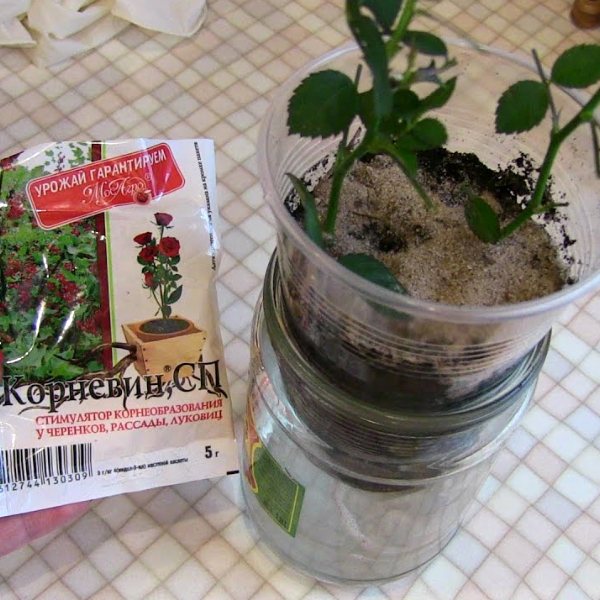

Kornevin - growth activator for rose cuttings
This list includes Heteroauxin and Epin extra. The method of application is indicated on the product packaging.
An interesting option is a solution made from scrap materials. For example, for this can be used aloe juice
... To do this, twist the leaves of the plant in a meat grinder, squeeze out the juice and add to the water at the rate of 1 part of the juice to 9 parts of water.
To prepare the simplest solution, take 1 a teaspoon of honey
and dilute it in half a liter of water. However, remember that when using store-bought products, the cuttings must be kept in solution for at least 6 hours, and in the case of homemade preparations, at least a day.
Landing in open ground
The best time to plant a cuttings that have developed roots in open ground is late spring. The landing site should be sunny, closed from drafts.
The size of the hole should correspond to the size of the roots. Organic fertilizers are used as top dressing. Before planting seedlings in a permanent place, they are shortened, leaving only 4 buds.
After planting is over, the earth is spilled and mulched with sawdust and peat. After about half a month, the seedlings will grow. When the shoots reach a length of 12-15 cm, the bushes are fed with complex fertilizers, as well as infusion of herbs and mullein.
Note! The first year the root system of the seedlings grows stronger. Therefore, during this period, all the buds that form are removed, which will help to concentrate all forces on growth. Before the coming cold weather, the flowers are reliably covered with protective material.
Some gardeners dig (especially valuable varieties) and store before spring, in a room where the desired temperature and humidity are maintained.
Landing in open ground
Method number 3: growing in a potato
An original and very effective method on how to properly plant and grow a rose from a bouquet is to use a potato tuber. The principle of operation of such a mechanism is to ensure optimal growing conditions and additional feeding with organic substances.
Potato preparation includes several stages:
- Strong medium-sized tubers are selected. They should be free of visible damage, signs of decay and other imperfections.
- Rinse tubers well with a brush, remove protruding eyes.
- Prepare a disinfectant solution of potassium permanganate and keep the clean tubers for at least half an hour.
- After that, the potatoes must be dried.
- A deep hole is made in the tuber, but not a through hole.
Rose cuttings must be inserted into the potato tubers prepared according to the above algorithm. For better germination, the roots can be moistened with a stimulating solution. Potato tubers with planted cuttings of roses are laid in shallow trenches (15 cm each) with sand covered at the bottom. The distance between the cuttings should be at least 15 - 20 cm so that the grown sprouts do not interfere with each other. Planting cuttings of roses in potatoes is carried out in late spring, so that the plants can take root sufficiently before the onset of cold weather. At first, the seedlings are covered with glass jars, which must be removed from time to time. If the landings are numerous, it makes sense to build a small greenhouse. Finally, the shelter from the planting of roses is removed after two to three weeks, depending on weather conditions. Correctly planted roses in potatoes do not need additional feeding for a year after planting. The seedlings are transplanted to a permanent place of growth for the next year.
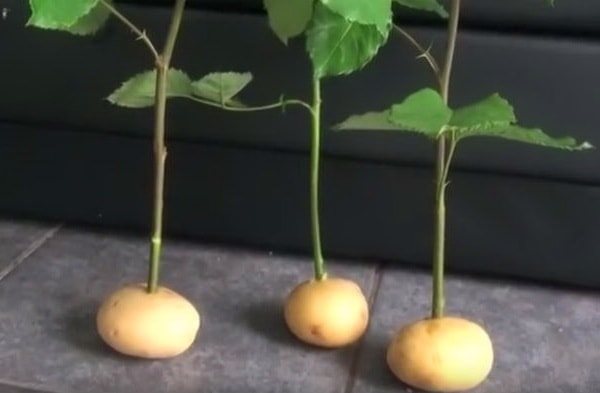

Method number 4: using the package
Probably the most original way to plant your favorite rose from a bouquet. This method is also called "burrito" as a famous Mexican dish. Its essence is very simple, and its efficiency is very high. Thus, even the “difficult” types of roses to grow will sprout.
The algorithm of actions is as follows:
- Selected cuttings of roses are kept in a solution that stimulates the roots.
- After that, prepared stems are laid out on a large newspaper.
- The newspaper must be well sprayed with water from a spray bottle, avoiding severe waterlogging.
- The cuttings are well wrapped in newspaper, the bundle must be put in a plastic bag or wrapped in foil.
- The bag with cuttings is placed in a dark, dry place. The temperature should be between 15 and 25 degrees Celsius.
- The bundle is unfolded once a week. All cuttings are carefully examined, decaying or darkened ones are discarded. The newspaper itself is re-moistened with water and again wrapped in a bag.
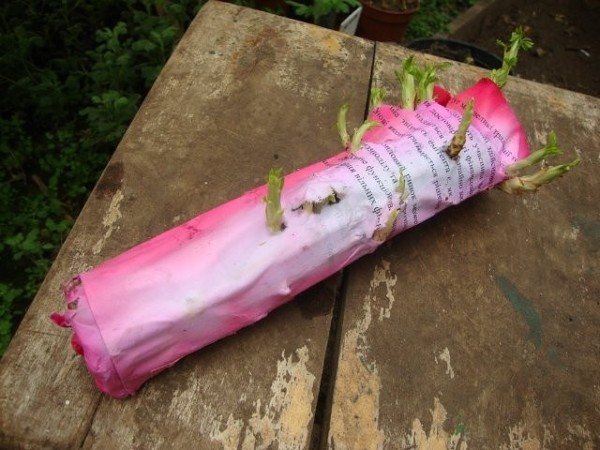

After about three to four weeks, the seedlings are ready to be rooted in the soil. You can clearly imagine this process, as well as study the intricacies of the "burrito" method, by watching the video of planting a rose from cuttings.
Growing a rose at home has many nuances. To do this, you can use a self-prepared stalk from a donated bouquet.The main secrets and the best ways to plant a rose from a bouquet are discussed in the information provided.
Florist tips
- If you add river sand or crushed shells to the pot where the cutting will be planted, this will help to avoid stagnation of moisture, and a sufficient amount of oxygen will also flow to the roots.
- If a decision is made to root roses from a bouquet, it is necessary to carry out preparatory procedures. Change the water in the vase every day. At night, the flowers sink their heads down into a bowl of water.
- A flower that has taken root in the winter must be brought indoors or moved to a greenhouse. Under natural environmental conditions, the bush is left only for the second year of life, while it is well insulated.
- Do not apply too much fertilizer. The very first application of top dressing is carried out with minerals when the plant reaches a length of a quarter of a meter.
- If buds appear on newly rooted seedlings, they should be removed so that the plant does not waste energy on flowering.
- In practice, the most effective cultivation of roses by cuttings is possible in those flowers, the buds of which are pink or red. More problems arise with yellow roses. The most problematic are roses with white flowers.
- When preparing the cutting, do not remove all the leaves on it, as this can contribute to poor juice circulation.
- Under any environmental conditions, after planting the cuttings in the ground, a shelter is made from cans or plastic bottles on top. This creates a greenhouse effect and protects the seedling from adverse environmental conditions. Jars are opened only after the cuttings have taken root.
Having analyzed and studied the methods of cutting roses, you can be sure that it is quite possible to grow a rose at home. The most important thing is the correct execution of all stages of work.
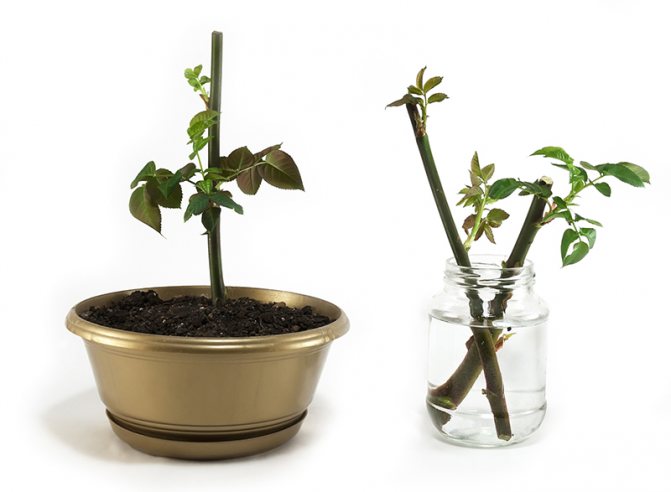

When we are presented with a beautiful bouquet of roses, we are sorry that they begin to die and we want to preserve this beauty. At this point, you can try to grow a new bush from a cut rose on your own roots.
After all, a cut rose is nothing more than a stalk capable of taking root and continuing its life.
Selection of planting material
Planting roses from a bouquet will be successful if you prepare the stalk correctly. Dried or sluggish stems are not suitable for this, the plant must be fresh. First of all, strong stems are selected that are in the lignification stage. Too thin and green will not work, as well as completely lignified. They can be easily recognized by the color of the stem and the dense "bark" on it.
If the bouquet has stood without water for a long time or it has not been changed daily, the chances of success will also be low. By the way, it is best to plant a rose from a cuttings from local varieties, but overseas hybrids are not suitable for these purposes. In the process of growing and transporting these flowers, many chemicals have been used that will make germination difficult at home.
For planting roses from cuttings, it is advisable to choose specimens with red and pink buds. It will be more problematic to grow yellow and cream roses, and snow-white ones are least of all suitable for planting and rooting with cuttings of roses.
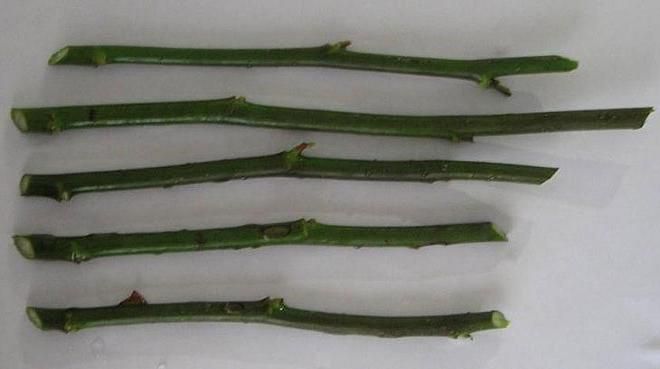

Preparing cuttings
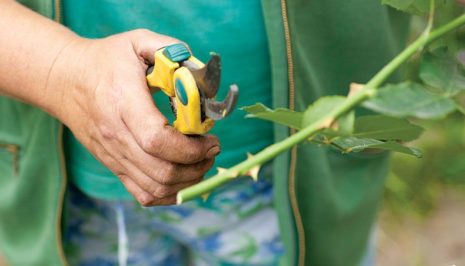

It is good if, at the sight of a bouquet, the hostess has the idea of growing roses from these shoots. Then she will immediately start preparing the cuttings, and they will not just stand in the water and rot at the cut. After all, the longer the decay process, the less likely it is that the processes will have their own roots.
Therefore, so that the ends of the roses do not rot them, before being lowered into water, they are cut by 2 cm and lowered into clean spring (or purchased) water. At night, the bouquet is placed in a deeper container so that only one bud head is on the surface of the water. After such care of the bouquet, it is necessary to start preparing the cuttings, without waiting for the complete wilting of the bud head.
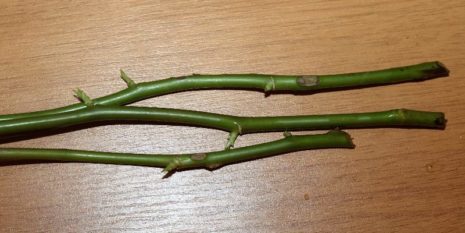

Here, referring to this important point, and cut the shoots from the bouquet. In this case, the lower cut is always made oblique with an angle of 45 degrees. The top cut should be blunt to reduce the evaporation of moisture from the cutting. The upper cut is made only 1 cm above the kidney. At the same time, on the process, the lower leaf plates are removed altogether, and the upper ones are shortened by half, reducing the evaporation of moisture from the cutting. The thorns must also be removed with a sharp secateurs. After all this, we can say with confidence that the cutting is completely ready to be rooted.
What kind of flowers can sprout?
Roses that have been in the store for a long time will never germinate: there are often drugs added to the water that extend the life cycle of the plant, but negatively affect root formation. As a rule, in such cases, the bottom of the shoot turns black, or the entire stem wrinkles slightly. Such flowers will never take root. Flowers purchased on March 8 are more likely to take root: they do not linger on the store counter, and spring only contributes to active vegetation, however, like summer.
You should also immediately stipulate: roots can appear on the stem of almost any rose, but this is not a guarantee that it will be possible to get a new plant, especially when it comes to Dutch hybrids. Most of the varieties imported from abroad are treated with special preparations that slow down the process of wilting of the plant, but at the same time reduce its ability to root. Therefore, roses grown locally are most likely to root (and later take root) in a vase.
The resulting rose will also be guaranteed frost resistance problems. In addition, cut plants have already spent a lot of energy on flowering, so often those who seem to be starting to release rose roots simply die when planted in the ground.
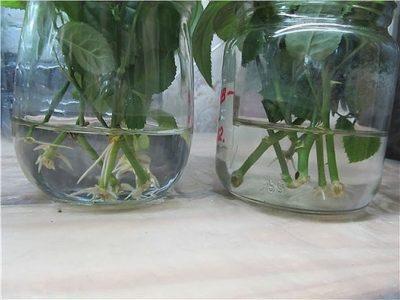

It is believed that the roots are more likely to appear on those stems that are placed in a vase of opaque materials (better than dark glass).- At the same time, the water in the container does not change, but is only topped up as it evaporates. Previously, you can throw an activated carbon tablet into it.
- The water should be boiled or melted, since pathogenic microbes are present in large doses in raw water.
- The level of water in the vase is also important: if there is too much of it, the stem will most likely rot, since there will not be enough oxygen in the container (roots form at the border of water and air).
- There must be leaves on the stem of a rose: according to experienced flower growers, it is the leaves that produce a substance similar to a biostimulator of root formation, for example, heteroauxin. However, the leaves should not be immersed in water, otherwise they can provoke putrefactive processes.
- Naturally, the room where the bouquet is located should be light and warm enough (+ 20C - + 24C).
How to grow roses from a gift bouquet
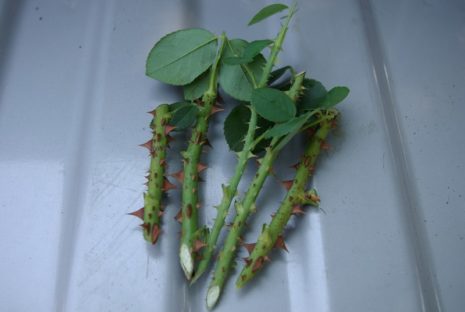

You can root roses at home all year round or in the summer immediately in the open field. For this purpose, you must have with you, in addition to prepared cuttings:
- a small container with drainage holes;
- nutritious soil;
- any stimulant of root formation;
- secateurs.
Having all this at hand, you can choose any method that will be convenient for the propagation of shoots.
Another way
In addition to grafting, you can use another method to grow a rose from a shoot. Flowers can be left in water, after adding an effective plant biostimulant to it, which promotes the growth of the plant's root system. As soon as the roots grow, they can be planted in the ground.
Roses are undeniably the most gorgeous flowers on the planet - they are delicate and passionate, light and vibrant, attractive and mesmerizing. Therefore, a classic bouquet for a first date is a composition of roses - white or red. Of course, after receiving such a bouquet, I immediately want to know how straight from a fresh bouquet.Immediately, we note that despite the great difficulties and a low probability of success in this matter, you still have a chance to get a real bush from a fresh cuttings. It is important to choose only the most beautiful, strong and healthy rose from the whole bouquet, or several roses with young buds - only they will be able to give a result!
Prepare in advance all the necessary materials to make or cuttings. In fact, there is no difference, the bouquet is already cut roses, but fresh cuttings are younger and are cut from a young rose hip bush. Growing flowers by cuttings is quite simple and here's what you need to do:
- Fresh and healthy rose;
- Scissors, knife or pruning shears;
- Potting mix for growing roses;
- Fertilizers, plant growth products;
- Pure water at room temperature;
- Container for cutting - a pot, box, or the like;
- Bottle, jar, or large plastic bag.
The most important thing is to get the right stalk from a fresh rose. To do this, cut the stem of the rose so that the bud is cut horizontally, i.e. evenly, and the bottom of the stem is at an acute angle. The length of the cutting should be at least 15 cm, and also have at least 2 buds, one of which will subsequently go deeper into the soil when planting. Use only sharp tools to trim the stem, leaves, and thorns, but leave a couple of healthy leaves on the cutting for photosynthesis. In order for the rose to give a shoot, make an incision at its end, as if multiplying it, and dip this part into the plant growth agent, so it is necessary to withstand at least a few hours. Now you can start planting in prepared soil, which should be moist, fertilized, and have sand in the composition. Put a bottle or jar on the rose for a greenhouse effect, but you can cover the entire pot with a plastic bag.
Rooting methods for cuttings
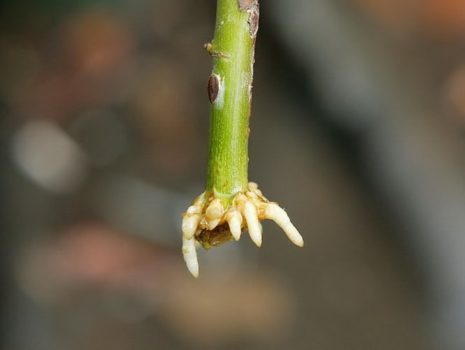

Rooting of cuttings depends on the variety of roses. If local varieties of roses are involved in the bouquet, then the shoots will give roots quickly and without problems. If a grower is going to grow roots on Dutch roses, then you can get a positive result on only 40% of the cuttings. This, it turns out, is due to the fact that roses are processed with certain hormones that slow down the process of wilting, but they also inhibit the formation of a root mass on the shoot.
Germination in water
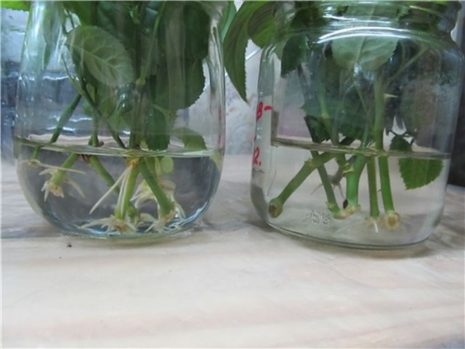

Germinating rose cuttings in water is the easiest option. To do this, they are immersed in water by 1/3. Water must be used filtered and separated during the day. The vessel is placed in that place:
- where there are no drafts;
- there are no rays of the direct summer sun;
- no sudden changes in temperature.
It should be remembered that the water is changed every other day. After about a month, white tubercles will appear at the ends of the cuttings - these are future roots. When the roots become 5 cm long, the shoots are planted in nutritious and loose soil.
Using potatoes
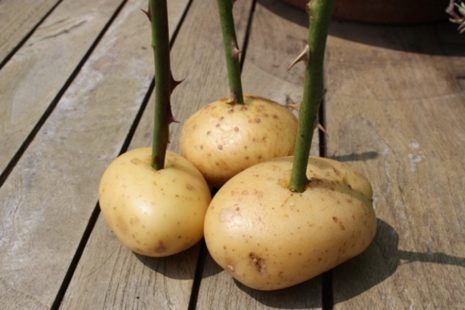

If you choose this method, then the potatoes will serve as a breeding ground for the formation of roots. The potato tuber must be:
- healthy;
- no mechanical damage;
- strong and resilient.
To prepare the selected potatoes, it is necessary to remove all the eyes from it, rinse under running water and make holes with an awl, where the cutting will actually be inserted.
In this way, you can grow shoots in an apartment, or you can immediately in the open field. To do this, a shallow trench is dug, no deeper than 15 cm, a 5 cm layer of sand is poured and potato tubers with rose cuttings stuck into it are already placed on it. When burying the processes, the apical bud should be left on the surface.
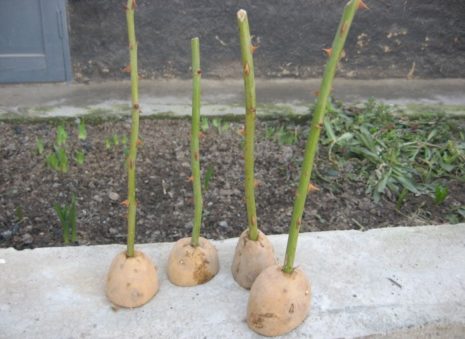

After planting, everything is spilled well with warm, settled water and covered with a cut plastic bottle to create a greenhouse microclimate. For the winter, such a shelter is not removed, but buried slightly with earth and then buried in snow. In the spring, a small bush will already be in place of the cutting.But such reproduction is suitable for the middle and southern regions of Russia; at the latitude of the Moscow region, young shoots must be additionally covered with spruce branches and lutrasil.
Using the package
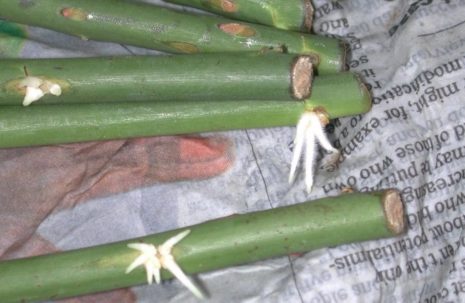

Today it is an unusual way to germinate the root system on a rose cut. All shoots are carefully wrapped in wet newspaper in such a way that cuttings do not peep out from under it. This wet bundle is placed in a black bag and put into a room where the air temperature will not rise above +20 degrees Celsius.


Rooting in a pot
This method is the most traditional. For this purpose you will need:
- Small capacity.
- Nutritious and loose soil.
- A glass jar large enough to cover a planted rose stalk.
- Shoots of roses.
The pot and expanded clay are poured over with boiling water to get rid of various fungal infections that may be there. The soil must be steamed in the oven for 20 minutes at 200 degrees - this is done to disinfect it from pests.
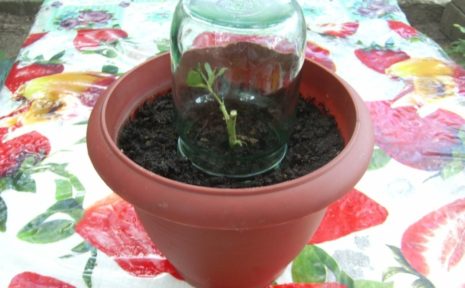

A 2 cm layer of expanded clay is placed in the prepared pot, the calcined soil is poured and well moistened. Now proceed directly to planting the prepared cutting. It is lowered with an oblique cut into the ground, deepening, so that the lower growth bud is submerged in the ground. The shoot is covered with a jar in order to form a humid greenhouse climate, this will give more guarantees for the viability of the cuttings.
If several cuttings of the same variety are planted in one container, then they are lowered into the ground with a step of 7 cm.
In the future, it is necessary to ensure that the soil under the jar or package does not dry out, but is moderately moist all the time. The temperature in the room where the cuttings will germinate should be in the range of 18-25 degrees Celsius. When small branches begin to grow from the internodes, there is no need to rush and immediately remove the jar. It is necessary to gradually accustom the young growth to the environment and the jar is raised by 2 cm so that air can enter under it. This will protect the cutting from black leg disease.
Second way
The same technology is used to cut a rose, but then the cuttings should be placed in water with a solution of "Heteroauxin" in a bright place, without access to direct sunlight. It is better to take a tall plastic bottle so that the cuttings fit entirely in it. At the same time, a microclimate with high humidity will be created, which is necessary for the formation of roots. After 2-3 weeks, a white outgrowth forms on the lower edge of the cuttings - callus, which is the rudiments of roots.
After that, the cuttings are planted in a pot and grown to an optimal state. This method is more laborious and does not always give the desired result. However, the first method does not guarantee success either. It is better to use both methods at the same time to increase the chances of a successful outcome of the operation. The time of grafting is also of great importance, as well as the characteristics of the rose variety that is supposed to be propagated. The best time for this procedure is the second half of summer and early autumn. In winter, it is unlikely that good results will be obtained.
A wonderful bouquet of roses, received as a gift, evokes joy, delight, tenderness. Unfortunately, the splendor of cut flowers does not take long to admire, as after a certain time they fade. Often this causes disappointment, regret, a desire to somehow preserve such a perfect beauty.
After reading the information on how to grow a rose from a bouquet in an apartment, you should try to apply the knowledge gained in practice. The process of planting, caring for the plant is unlikely to be too easy, however, following the recommendations below, you can cope with all the difficulties.
Selection of source material
The florist will need to prepare the source material by choosing specimens from a bouquet with live leaves, buds, strong, sturdy stems that are in the lignification stage. Conclusions can be drawn about this by paying attention to the color of the shoots, the compaction of their skin. It is necessary to abandon the use of immature, overly thin petioles, as well as completely lignified specimens with a thick core.
Roses that have stood in non-replaceable water for several days will be unsuitable for rooting, since harmful microorganisms are guaranteed to penetrate into the tissues of their stems. It is best not to postpone grafting for a long time, but to carry out the procedure in the evening of the same day when the bouquet was presented or purchased. If it is impossible to perform the work promptly, you should leave the flowers overnight in clean, cold water, after cutting off the ends of their stems by 1.5 cm.
In order for the grafting of roses to be successful, it is advisable to give preference to fresh flowers cut at the beginning of the summer season, grown in local climatic conditions. The varieties imported from abroad are subjected to chemical treatment, which negatively affects their rooting ability.
As practice shows, effective cultivation of roses by cuttings can be counted on using stems topped with pink or red flowers. The rooting process for specimens with yellow, orange petals is considered more problematic. The least chance of success is when working with cuttings of white roses.
To count on good cuttings of roses from a bouquet, it is advisable to perform a similar procedure at the end of spring - in autumn. It is worth noting that in June the growth of shoots is the most intense, in August-September the vitality of the plant decreases, which negatively affects the process of root formation.
Choosing a different timing may cause poor rooting of cut specimens. The most unfavorable period is considered to be January - February. At this time, the results of the work of an inexperienced grower may be negative. How to properly grow roses from a bouquet in winter at home: you will need to ensure that plants maintain optimal illumination, temperature, humidity.
Harvesting cuttings of roses
For the first stage of work, you should arm yourself with a sharp knife, pruner. This will avoid unnecessary injury to the cut stems. An experienced florist, who knows how to propagate roses by cuttings, must first disinfect the tool in order to exclude contamination of the planting specimens.
For roses selected from a bouquet, unopened buds and blossoming flowers are removed. Then the stems are cut into cuttings (15 - 30 cm long).
The technology of the procedure is as follows: an oblique cut is made under the lower kidney with an indent of 1 cm, and then a straight cut is made above the kidney located above. As a result, you need to get pieces of stems, each of which will have 2 - 3 future buds of shoots. It is allowed to prepare cuttings of roses (6 - 8 cm long) with one bud located in the middle, in the presence of a small number of flowers in the bouquet.
From the resulting planting material, the lower leaves are removed, and the upper ones are shortened by 1/3.
This procedure will help preserve moisture and prevent the shoots from drying out. Tearing off all the leaves is discouraged as this can adversely affect sap circulation. The last thing to do is to get rid of the thorns on the stem.
Use of growth stimulants
Next, pour clean, settled water into the prepared container and dilute the root formation stimulator in it. You can use purchased drugs (Kornevin, Epin, Heteroauxin, Charkor), the recommended dosage of which is published on the package.To stimulate the rooting of roses, cuttings are placed in the resulting liquid with immersion 1/3 of the length for 6 hours.
You can also use a solution containing water (glass), aloe juice (20 drops) or honey (teaspoon), the cut stems are soaked in it for at least a day.
Cutting bouquet roses in autumn
Autumn is a good time to sprout a rose stalk. This method has several advantages:
- Such an adult bush will not have rose hips.
- Roses on their own roots tolerate severe winters well.
- The shoot can be easily obtained from a donated bouquet or ask your neighbors in the country.
The term for cuttings coincides with the pruning of the shoots for the winter. Therefore, grafting takes place at the end of October. The cuttings are prepared in the usual way and proceed to planting. They are immediately planted in a permanent place and this is a huge plus in the propagation of roses. The shoots treated with a growth stimulant are lowered into the ground at an angle of 45 degrees and spilled abundantly with water. After planting, 1-2 growing buds remain above the ground. All cuttings are covered with glass or plastic containers and removed in spring with the onset of steady heat.
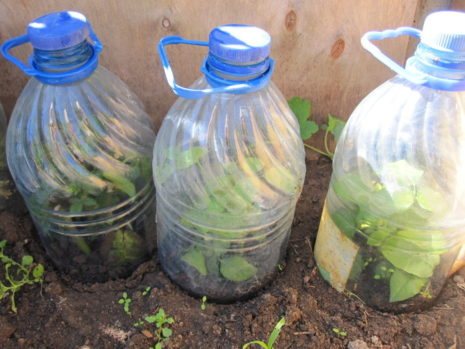

Method one
After the buds wither, you need to cut the cuttings from the stems, for this you need a sharp razor. Several cuttings can be prepared from one pink stem; three buds must be left on each section of the stem. The lower cut is made under the sheet, it must be done at an angle of 45 degrees, and the upper cut must be made above the kidney and made perpendicular to the trunk. The bottom sheets must be torn off, the top ones can be left.
Then you should put the cuttings in a solution of "Heteroauxin" or "Kornevin" for 10-12 hours, then plant them in the nutrient soil at an angle of 30 degrees, deepening them to the middle bud. The soil around the cuttings must be squeezed and shed with water. Each stalk should be covered with a cut-in-half plastic bottle with the cap unscrewed (for ventilation).
In order to maintain the desired microclimate, the cuttings should be periodically sprayed with warm water and watered, without lowering the drying out of the substrate. After 3-4 weeks, fresh shoots will appear from the buds, and miniature roots will form on the roots. After another 2-3 weeks, you can transplant the seedlings to a permanent place in a garden or a voluminous pot.
Is it possible to root flowers from a bouquet in winter
There is no definite answer. It all depends on which rose the stem is taken from. With a Dutch rose in winter, the root system on the shoot cannot be obtained unambiguously. You can try to cut a local rose, but the process will be quite lengthy and even when the sprouts grow from the sinuses, the shelter should not be removed, since the roots are formed very slowly, and the sprouts can grow at the expense of the main stem. The best choice is to plant the stalk in a clear plastic cup in winter so that you can monitor the formation of roots. But the rooting process will be long, if in the summer in a month you can get small roots on the shoot, then in winter the cutting can stand all winter and only with the onset of spring will it begin to build up the root system.
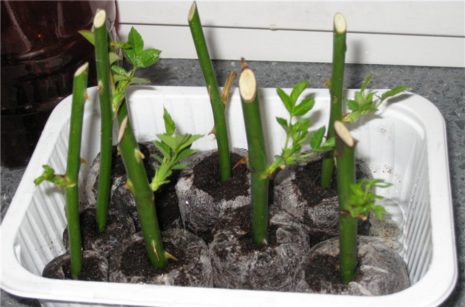

Mistake 3: incorrect summer pruning
Pruning roses in summer is a very important care element. Therefore, it is worth paying attention to the two most common mistakes in this area.
Withered flowers remain on the branches
Many gardeners never remove wilted flowers from a bush. The petals fall off, and the fruits seem to remain on the branches that do not interfere with anyone. But only "kind of like" - in fact, this is wrong. Such carelessness in care can call into question all subsequent flowering of the bush this year.
Photo from the gardener's magazine site
Why is it wrong?
Because, as it should be in nature, the plant will consider its mission of flowering completed and will begin to "work" on the formation of fruits and preparation for winter.But we need the rose to bloom! Therefore, it is necessary to cut the flowers without waiting for them to wilt, which stimulates the bush to further flower formation.
And how to perform such a summer pruning of roses is shown in this video:
The work will not take long, and the benefits are enormous.
Shoots without flowers are ignored
Unfortunately, we practically do not pay attention to blind shoots - those that do not bear flowers, believing that "the bush itself knows where to give flowers and where not."
Why is it wrong?
By ignoring these shoots, we ourselves are depriving ourselves of many new flowers. But it is enough to activate such shoots by pruning, and they will turn into blooming!
The following video explains and shows in detail how to correctly conduct a stimulating blind shoot pruning:
It is worth cutting off blind shoots correctly, and the appearance of new flowers will not take long.
What you need to transplant a rose
To get a beautiful bush from a donated flower, you must first root it, and then plant it in the ground. You do not need any special devices for this - it is enough to have:
- sharp knife, secateurs;
- flower pot with numerous drainage holes;
- a plastic bag or cut plastic bottle to create a micro greenhouse;
- soil suitable for rooting;
- good drainage.
You will need a complex fertilizer that causes the growth of the root system, a spray bottle to maintain the necessary moisture.
Mistake 5: eating the wrong way
Many inexperienced gardeners try to feed their favorites as best they can during flowering ... and make a huge mistake.
Why is it wrong?
It is not always good to feed the plant. Such a seemingly good deed can sometimes lead to the loss of flowers, and even to the death of a rose bush.
It is important to understand when and what fertilizers does a rose need
, and what will be harmful for her:
- It is important for a plant to receive a complete complex fertilizer, including nitrogen, potassium and phosphorus in equal proportions, in early spring, and during flowering it will only bring harm.
- Nitrogen is needed in spring and in the first half of summer for the active growth of shoots and leaves, and in the fall it will become an enemy for the plant, because the new shoots, the growth of which it will provoke, will not have time to get stronger and will almost certainly freeze out in winter.
- Phosphorus and potassium contribute to abundant flowering, so they will be useful and appropriate during the budding period.
- The last feeding is carried out in mid-September using a phosphorus-potassium mixture, and later fertilization will not bring any benefit.
- Overripe and semi-rotted manure is an excellent organic fertilizer, and fresh manure will cause burns on young roots.
- During the flowering period, it is advisable to suspend any feeding altogether.
In the next video, Irina Makhrova will show us how rose bushes are fed in practice:
If you want your roses to be healthy and happy with abundant flowering, feed them correctly.
Preparing rose cuttings
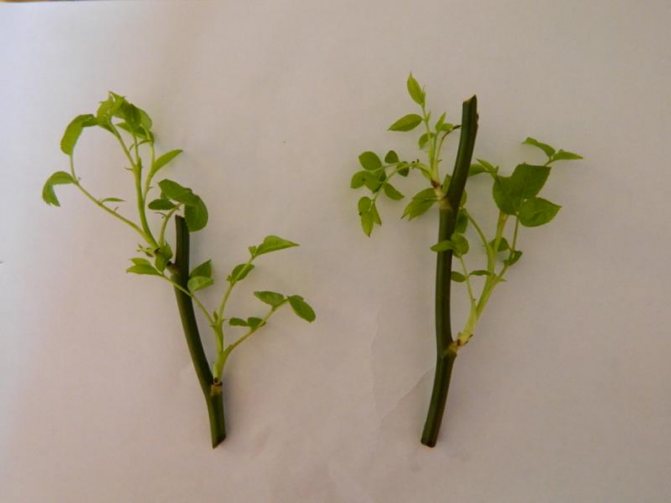

There are nuances that you need to pay attention to if you want the rose to take root. When choosing stems on which new shoots have sprouted, preference is given to large, strong, without damage. It is taken into account that imported flowers are treated with chemicals that extend shelf life. This worsens the chances of root formation. Your best bet is to try and plant a Russian rose.
A sharp knife or pruner is used to cut the cuttings. The preparation process is always the same, no matter what material is used - a purchased bouquet from the salon or a branch plucked from a bush in the garden.
- The location of the cuts on the selected stem is determined - on the cuttings, in addition to the hatching shoot, there should be two more buds. The length varies from 5 to 15 cm.
- The upper cut is made horizontally, at a distance of at least 2 cm from the upper kidney.
- Under the lower bud, the stem is cut at an angle of 45 °, creating a vast area for the absorption of moisture and nutrients.
- The leaves are cut off completely from the bottom, leaving a small stump.
- The upper leaves are cut in half each so that the sap flow does not stop, but the need for nutrition is reduced.
- The cuttings are placed in water in which a growth stimulant has been previously dissolved - Kornevin, Rostok, Heteroauxin, aloe juice or honey.
Water is used only settled or rainwater, boiled water will not work. Cuttings can be planted in 1-2 days.
Mistake 1: choosing the wrong landing site
A mistake would be to plant a rose just where it “will be beautiful”.
Why can't a rose be planted everywhere?
To grow a healthy and abundantly flowering rose bush, you need to know where the plant will feel cozy and comfortable. Without taking into account the specific preferences of the rose, it is impossible to count on a beautiful flowering and longevity of the bush. What are its features that cannot be ignored?
It must be remembered that roses:
- photophilous
... Light has a decisive effect on growth vigor, flower number and resistance to fungal diseases. The more light, the better the rose feels. At the same time, some varieties of roses feel great in the shade, therefore, like people, there is always an “individual approach” to roses. - thermophilic
... With a lack of heat, the accumulation of nutrients necessary for the normal development of a rose slows down. Cold northern and northeastern winds “take away” most of all, so it is advisable to protect roses from them. - do not like wet soils
... Prolonged exposure of the roots in water leads to the extinction of the bush from a lack of oxygen. In addition, in winter, wet soils are cooled more, and the plant can freeze out. - prefer neutral soils
... The ideal (pH) for roses is 6-7. In neutral soils, the rose most easily assimilates the nutrients found there. With an increase or decrease in pH, some of the substances pass into a form inaccessible for assimilation by the plant. - feel bad under the trees
... If your rose grows in the shade of trees, don't expect flowers from it. Trees will take away water and nutrients from it, because of the shade, the shoots will begin to elongate, become thin, the resulting false buds will not bloom. And the likelihood that the plant will suffer from fungal diseases also increases.
In short, we must not forget that roses are queens. The place where they will feel comfortable and delight you with flowers should be sunny, protected from cold winds, located at a relative distance from the trees.
Our catalog contains rose seedlings from large online stores and collectors. For example, you can.
Soil and pot
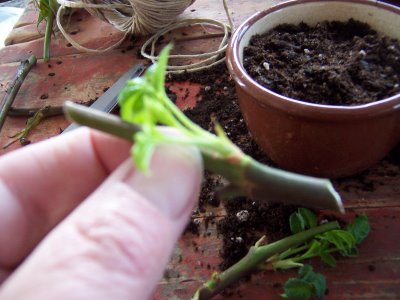

A well-chosen pot and soil is half the success of rooting a rose. Roots will definitely appear if you create suitable conditions for this.
Priming
You can buy special soil for roses at the store. The main condition for the soil is its lightness, looseness and the ability not to retain excess moisture.
The earthen mixture is done independently as follows: combine 2 parts of humus, 2 parts of garden soil and 1 part of pure river sand. Heavy soil is mixed with sand in a 1: 1 ratio. Disinfect with a weak solution of potassium permanganate or by calcining in the oven.
Pot
The height of the pot chosen for the cutting should be at least 20 cm. A layer of high-quality drainage on the bottom is required - first of all, small roots are ruined by stagnant water. Expanded clay can be poured into the pallet.
It is better to choose pots from natural materials - clay, ceramic. This will provide oxygen access to the root system.
Mistake 2: improper planting of grafted roses
If the rose is grafted, then when it is planted, the graft site is a weak link that needs to be paid special attention to. A rose is considered to be correctly planted, the grafting site of which was 3-5 cm below the soil level. At the same time, in areas with sandy soils, planting may be a little deeper, and on clay soils, on the contrary, a little shallower.
Why is it so important?
- If the grafting site during planting remains above the soil surface, then new buds and shoots on the seedling will form where it is well lit by the sun - that is, they will appear on the rootstock (rosehip). The resulting wild growth will begin to take food and moisture from the cultivated part of the rose, which will certainly weaken its development.
- If the graft site is deeply deepened, then the rose does not take root well, and with watering, the root collar can rot, rot - then the rose will die.
But for climbing roses, when planting, the grafting site needs to be deepened more - about 10 cm below the soil level. In these roses, it is with such a planting that roots are formed on the cultivated part of the seedling, and the buried roots of the rosehip do not give growth.
You can find a huge assortment of roses in our catalog, where products from various garden online stores and collectors' offers are presented. .
Transfer
When the cuttings have stood in the water for 1-2 days, and the pots of soil are already prepared, they begin to plant. It has been noticed that spring and early summer is the best time for rooting roses from bouquets.
- A hole of a suitable size is made in a pot - only 1-2 upper buds are left on the surface, the rest of the cutting will be underground.
- The lower cut of the stem is dipped in a dry powder fertilizer, Kornevin, for example.
- The stalk is lowered into a hole, covered with earth, and the surface is slightly compacted.
- Pour with water at room temperature.
- A bag is put on the pot, after having inserted spacers into the ground - wooden skewers, sticks for sushi will do.
- From below, the package is fixed with a rubber band, creating a greenhouse effect.
The pots are placed in a cool place, the optimal mode is +18, + 20 ° С. Lighting should be diffused, not too intense, direct sunlight is unacceptable. Spraying the stem is carried out daily - in the first week up to 7 times a day, then gradually brought up to 2-3 times. Every day, the bag is removed for a few minutes to prevent waterlogging. When new leaves appear, the airing time is gradually increased, and when the plant gets stronger, they are completely removed.
Increased chances of survival
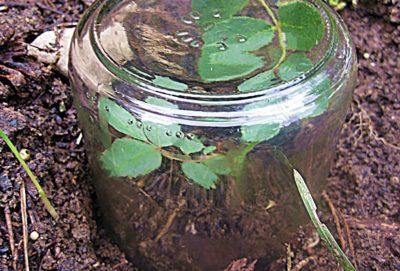

The rose takes root in conditions of high humidity, therefore, it is advisable to cover everything on top with a glass jar or plastic bag to increase the chances of survival of the cutting.
Experienced flower growers recommend not to remove the jar until it is clear that the rose has begun to grow (it releases new shoots and leaves).
And only then the "greenhouse" can be opened for a short time, gradually accustoming the young plant to the dry air of the environment that is unusual for it. The total duration of time from the moment the cuttings are covered with a jar and until the moment they are removed is about six months.
How to plant a rose in a potato
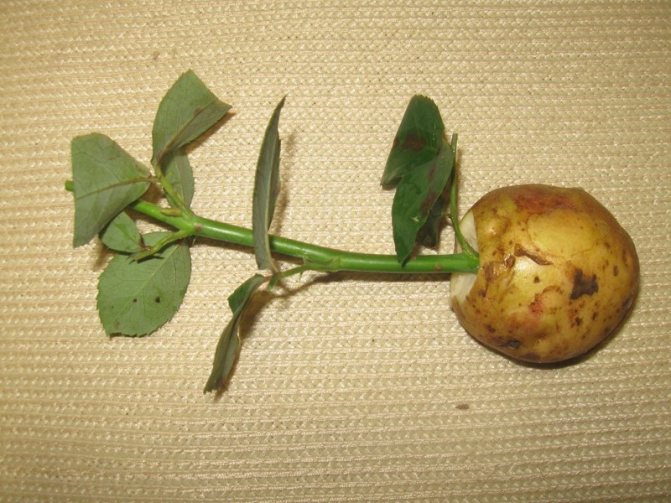

An interesting way to facilitate the care of the cuttings, the potato becomes at the same time a source of moisture and essential substances. Previously, all the eyes are cut out of the tuber so that sprouts do not appear. The pot is prepared so that the potato fits easily, leaving more room for the soil.
- A hole is made in the middle of the tuber, which will allow the stem to hold tightly in it.
- The lower cut of the stalk is dipped in dry Kornevin fertilizer.
- Insert the stem into the tuber.
- Together with the cuttings, the potato is placed in a hole and covered with soil, leaving 1-2 buds above the surface.
- Sprinkle with water.
- Cover with a bag or glass jar on top, creating a microclimate.
In the future, the handle is looked after in the same way as in the previous method. Using a potato to root a rose will avoid infections and rot that can destroy weak young roots.
Mistake 4: surface watering
Roses should not feel a lack of water. Gardeners who watered roses superficially, make a serious mistake: such watering, even if it is carried out daily, will not bring results.
Why is it wrong?
Surface irrigation is so named because only the surface layer of the soil is soaked, and moisture does not reach the roots. And with visually well-watered soil, the plant remains not watered.
How to water properly?
- It is best to make a circular hole with a depth of 12-15 cm just before watering, fill it with settled water, and after the water is absorbed, fill it with earth (it is also good to mulch).
- The approximate frequency of watering: during active growing season - once every 7-10 days, and in dry hot weather - after 3-5 days.
- One-time watering rate is from 5 to 10 liters per 1 bush for ground cover roses and from 10 to 15 liters for climbing roses.
- It is impossible to water the rose in the very heat. This is best done in the evening. But if you water by sprinkling or spraying from a hose, then it is not recommended to water either on a sunny day, so as not to cause burns to the plant, or in the evening, because the leaves that did not have time to dry will become the gateway for fungal infection.
- It is recommended to reduce watering at the beginning of autumn. The only exceptions are those varieties of roses that continue to bloom actively.
Advice
You can check whether the stalk was able to take root by the appearance of the stem in the pot - if it has not turned black and dry, and new leaves appear regularly, then the roots have appeared and are actively growing. If a month after planting, the stalk did not give a single new shoot, and the leaves that were there wilted, then rooting failed.
Experienced growers say that a young plant should not be planted in open ground in the first year of life. They give a bush in a pot to grow stronger, carefully caring for it, and plant it in the garden only for the next season. The first buds that appear immediately after transplanting are removed so that the rose does not waste energy on flowering.
Practice shows that the longer the bouquet stands, the less chances for the stems to take root. Therefore, when you want to grow a rose from a donated composition, get down to business without waiting for the flower to wither.
Cuttings can be kept in water until roots appear and only then planted in the soil. In this case, the water is regularly changed, but if the roots have not hatched within 2 weeks, then the attempt was unsuccessful.
Hibiscus at home in a pot
It is not known for what reason, but hibiscus is called the Chinese rose, although there is no external and characteristic similarity between the two different types of flowers. Although reproduction and love for certain climatic conditions can still be traced. Anyway, if you decide to plant a Chinese rose at home, remember that this flower is quite controversial. If you believe in omens and superstitions, follow the laws of Feng Shui, then know that hibiscus has several symbols:
- Attracts feelings, especially love;
- Supports and retains negative energy in the room;
- It is the flower of death.
It's up to you to believe these definitions or not. If you really want to grow flowers on the windowsill, then anyone can like hibiscus for these purposes. Before planting a rose in a pot, remember what conditions are most suitable for a Chinese flower:
- Warm room. In winter, the air temperature here should not drop below 14-15 degrees, and in summer it is advisable to adhere to a temperature of 22 degrees;
- A bright place. Here it is worth choosing a well-lit area, but without direct sunlight;
- Moisturizing both soil and plants. Water the Chinese rose well in summer, but from autumn to spring, the frequency and abundance of watering should be reduced. Remember to spray the stems and flowers of the hibiscus;
- Nutritious soil. To do this, feed the soil with nutrients every month.
To plant a Chinese rose at home, you should use the cuttings method. A stalk can be obtained from an adult hibiscus.
- Place the resulting seedling in water until the first roots appear;
- Transplant the rooted cutting into the soil:
- Use a simple flower pot;
- Lay a drainage layer on the bottom of the pot;
- A soil mixture is poured over the drainage;
- The seedling deepens into the substrate and is covered with a plastic bottle or plastic bag;
- Water the soil with the cuttings regularly so that it does not dry out;
- When leaves appear on the cutting, stop creating the greenhouse effect.
Rooting a purchased rose is not so easy, but quite possible. The success of this operation will vary depending on the origin of the rose, its variety and the quality of the presale. If the rose was cut for a long time and was treated with special preservatives for better preservation, it will hardly be possible to root it. In case the rose is fresh, you can try to do it. However, even in this case, it is unlikely that it will be possible to grow a chic rose bush in the garden - greenhouse roses are grown for cutting, which are not adapted to the conditions of open ground and the harsh winter. If the desire to plant a rose is not, you can try to root it in different ways.
Time frames for grafting roses
The most successful will be the propagation of roses by cuttings that were cut in the first summer months. It is advisable that the flowers are previously grown in the local climate and not treated with chemicals to prolong the life of the buds.
The best times for germination of cuttings are June days, while in August it will be more difficult to achieve the formation of roots on the stems. The hardest part is to grow the plant during the winter months, and keep the cuttings of the roses until spring.
The best option is to start rooting cuttings on the very first day of receiving roses. In this case, the chances of success are greatly increased. So what needs to be done?
Carefully removing the blossoming roses, unopened buds and all leaves and thorns, except for the topmost ones, it is necessary to cut the stems into cuttings 20-30 cm long.The lower end of the cutting should be cut at an angle, armed with a sharp knife, and the upper end should be cut in a straight line, and then treat with paraffin. Ready cuttings should be placed in a concentrated solution of potassium permanganate for 24 hours.
Choosing a plant for cuttings
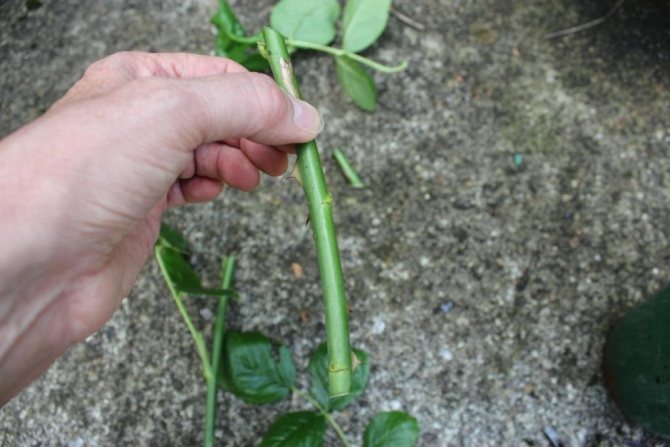

Like any business, getting productive shoots from a rose should follow certain rules:
- The plant from which the cutting is taken must be healthy. The stem of the rose should be chosen not thin, but juicy, green.
- The middle part of the branch is used.
- The handle should have two or three large buds. They cannot be dark.
- It is advisable to take blanks from growing plants. If a stem is taken from a flower from a bouquet, then it should be freshly cut, and not a month old. When stored for a long time, flowers are treated with chemicals.
It happens that roots appear on purchased beautiful imported roses. Of course, you can try to plant it. But such a shoot is unlikely to take root, and if this happens, it will not survive the winter, since the plant from which the roses were cut is not zoned, that is, it is not adapted to our climate.
How do you know that they have taken root?
You can take cuttings from a rose only when the flower begins to shed its petals. After the flowers stand in the water, a process with young leaves may appear on the stems. This is the element that can be used to further preserve the plant. If there are several such processes, then you can try all of them.
It is not a fact that the flowers will survive, because often shop roses are infected with various pests, they are sprayed with harmful substances that artificially prolong the preservation of the bouquet, but reduce the survival rate of the flower to zero.Therefore, it is always advisable to rinse and trim the stems of the plant before placing it in the vase.
Cutting - what is it?
A cut is meant a part separated from the plant and used for further germination. As a rule, a stalk is a stem, less often a branch or leaf of a flower, with which you can breed a new bush. Young freshly cut shoots are most suitable for vegetative propagation. Cutting is the process of rooting a segment of a plant, with the further formation of new roots and buds. Even from a branch of short length, subject to all the necessary conditions, a new luxurious plant can grow.
Rooting shoots with potatoes
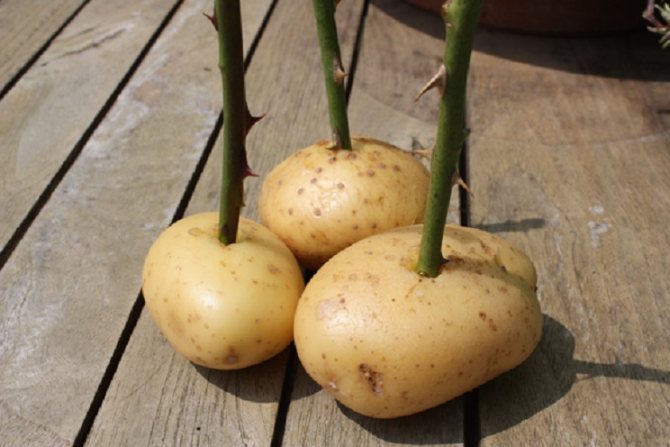

How to plant a rose shoot from the stem and what other germination methods are there? A slightly unusual, but effective way using ordinary potatoes. This will require several young tubers, the number of which should be equal to the number of cuttings. They contain nutrients. Potatoes must be carefully prepared before use. To do this, they are washed, treated with a weak solution of potassium permanganate, all eyes are removed and dried.
It is necessary to inspect them so that there is no damage. A hole is made in each potato, into which the stem of the rose is immersed. The tuber is placed in the ground and covered with earth in a layer equal to 7 cm. One bud is left above the surface. Pour with a weak solution of potassium permanganate and close with a plastic bottle. After about 15-20 days, the first leaves appear, after which the bottles are removed.
This method gives 90% rooting of the plant. It is relatively new, but a large number of positive reviews show its effectiveness. It is suitable both for planting a rose directly into the ground, and for planting in a pot, which should be high.
Where to buy a seedling?
Rooting a rose cut is a fun process, but more for fun and experimentation. Currently, flower shops, private and suburban nurseries, botanical gardens offer a lot of varieties of roses: tea, park, Dutch, bush and peony roses. Specialized companies are ready to shower growers with various hybrids, of which there are more and more every year.
Buying an already adult flowering plant is an unjustified risk. and a waste of money. The grown rose, most likely, will not take root in a new place, getting used to the greenhouse conditions. A safe bet is to buy an already rooted rose cut in a container. A large seedling with its own root system and green mass will cost a resident of Moscow 550 - 700 rubles, depending on the variety. Nurseries of St. Petersburg offer seedlings to local residents in the price range from 270 to 380 rubles.
Landing in a permanent place
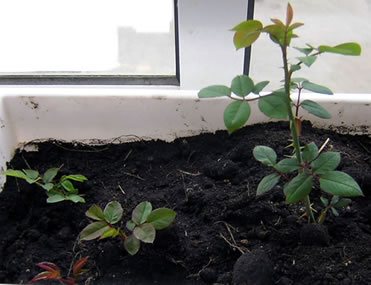

The optimal time for planting rooted cuttings is late spring. A gardener who knows how to grow a bush from a bouquet of roses will probably prefer a sunny, sheltered from the winds, not flooded area.
The dimensions of the dug holes must correspond to the size of the roots, organic matter is used to fertilize the soil. Before identifying seedlings in the ground for a permanent place of growth, they will need to trim the stems, leaving a maximum of 4 buds.
After the end of planting, the soil must be watered, mulched using peat, sawdust. Bushes should provide reliable shading. The start of the development of seedlings can be expected in 2 weeks. After the growing shoots reach a height of 12 - 15 cm, you will need to feed the bushes using complex fertilizers, infusion of mullein, herbs.
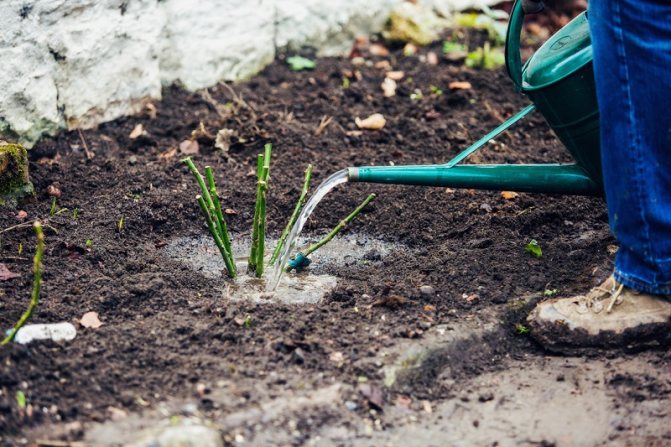

During the first year, young plants root thoroughly, which is why it is required to remove all buds that form from them. This will give them the opportunity to focus all their energy on growth. In anticipation of the onset of cold weather, roses should be provided with reliable shelter.
Prudent florists practice digging up especially valuable varieties, storing them until spring in a room with maintaining the desired humidity level, preventing the roots from drying out.
How to save shoots?
Before planting, cuttings need proper maintenance. For successful rooting, the correct plant segments must be selected. Cut shoots from rose bushes are suitable as material. It is worth separating the cuttings after the formation of buds on the bush - this method is called green cuttings. At this point, the plant has accumulated a sufficient supply of micronutrients to survive pruning.
There are several proven ways to save cuttings.:
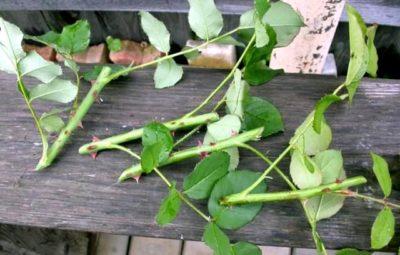

Freshness and vitality of cuttings can be provided by sphagnum moss, which helps to maintain optimal moisture. The shoots wrapped in moss should be stored in the refrigerator at a temperature not exceeding +5 degrees.- If you have a summer cottage, you can dig a hole 20 centimeters deep. The bottom should be laid with soft cloth and the cuttings should be buried until spring.
- If you have a limited supply of materials at hand, you can arrange for the cuttings of roses to have a simple but reliable wintering on the bottom shelf of the refrigerator. The shoots should be wrapped in a slightly damp cloth and placed in a cool, dark place until spring.
- If rooting is delayed for several days, the cuttings can be placed in warm water with a few drops of Epin.
When using natural moss to preserve cuttings, it is necessary to carry out preliminary disinfection. For these purposes, the drug Fitosporin-M is perfect.
Rooting shoots with paper and bags
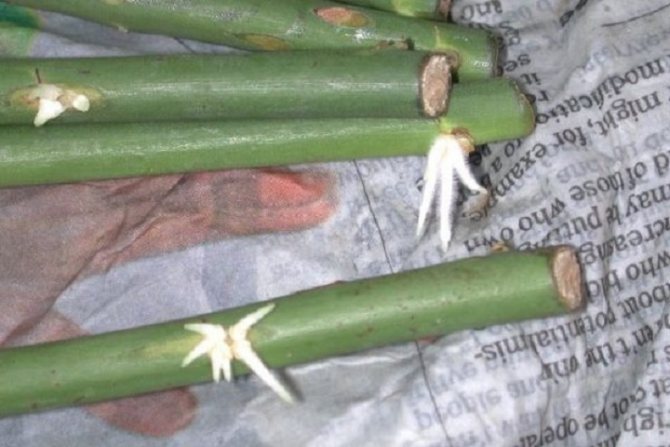

There is another way for the rose to grow on the stem. How to plant it in the ground? Prepared cuttings are taken out of a jar with a growth stimulant solution. Soft paper or newspaper is laid out on the table, on which prepared cuttings are placed. A neat bundle is made, which is moistened with water and placed in a bag. It is there at temperatures between 18 and 20 degrees.
After 5-6 days, the bag is opened and the planting material in it is checked. If necessary, the newspaper is moistened with water. Cuttings, where rot has appeared, are removed and at the same time the paper is changed, since the microbes remaining on it can spread to healthy branches. The first small roots appear after a couple of weeks. After the rose has sprouted, it must be planted in a permanent place of growth.
How to prepare cuttings for planting
Gardeners know that all woody plants, including roses, root best when buds are just beginning to acquire their color on a young shoot, that is, even before flowering. It is then that the shoot passes from a herbaceous state to a lignified one.
When choosing branches, pay attention to their thickness. As practice shows, flowers reproduce most successfully from thin, sufficiently mature shoots. They can be distinguished by their color: they are no longer green, but are just beginning to acquire a brown tint. The best option is to cut the seedlings into three buds. This is explained by the fact that weak plants grow from short branches in the first year.
To prepare planting material, you need to do the following steps (picture 2):
- Make the lower cut of the future seedling just under the bud, stepping back from it by 1.5 mm. In this case, the cut line should be oblique, and the length should be about 15 cm.
- Make an upper cut in a straight line, 1 cm above the kidney.
- Remove the lower leaves and shorten the upper ones by a third of their length.
- Remove all thorns.
- Tie the cut sprouts into bunches and place them in cold water (a special solution - root, for example) to stimulate root formation. The water should be changed every two days.
- After the emergence of the embryo of the roots (after 15-20) days, transplant the plant into open ground, or into a prepared container with soil.
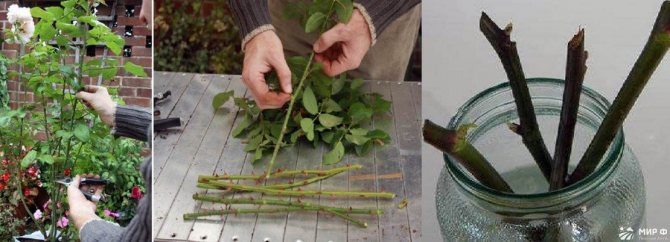

Figure 2. Harvesting of seedlings of culture
In this way, you can prepare cuttings for any type of planting, regardless of the season.
Cuttings in autumn
Such reproduction in the fall is carried out in order to preserve the planting material until spring in a viable state. This is explained by the fact that keeping them in the house all winter is quite inconvenient, therefore, the landing method is used before the winter.
Simply put, they are buried in the ground, and covered with a dry shelter on top to keep warm. With the arrival of spring, it is transplanted to a permanent place in the usual way.
How to cut cuttings
If you want to decorate your garden with roses, you need to know how to cut the seedlings for planting. First you need to choose the right shoots suitable for cutting. Freshly faded stems, or those that are just about to bloom, are best suited. Their characteristic feature is the easy removal of thorns.
Then the shoots are cut with a sharp knife or pruning shears into pieces 15 cm long. It is necessary to ensure that there are three buds and several leaves on each cut stem. In this case, the cut under the lower kidney should be oblique, while the upper cut is drawn above the upper node at a height of 2 cm in a straight line. The lower leaves and all thorns must be removed (Figure 3).


Figure 3. Rules for cutting shoots for planting
The cut branches are dipped in a lower cut into cold water or a special solution to stimulate the development of the root system (root). You can make this stimulating mixture yourself from a teaspoon of honey and a glass of water.
How to keep cuttings in the winter
Experienced florists recommend, with the onset of cold weather, to transfer the grown plants to a room with the required humidity level. In the spring, overwintered plants are planted in a permanent place in a flower garden.
You can save them in the winter using the warm dry shelter method, in which case the plants can not be tolerated, but simply covered with mulch.
Useful video
We suggest watching a video on how to root a rose from a bouquet that has already sprouted in a vase:
If you find an error, please select a piece of text and press Ctrl + Enter.
Rose sprout in a vase how to plant? This question is asked by those who do not want to part with their favorite flowers. Such a rose can be planted in the soil and, with proper care, it will delight with its flowers for a long time. This article provides information on how to grow a rose from a cut flower.
How to "force" them to sprout young shoots?
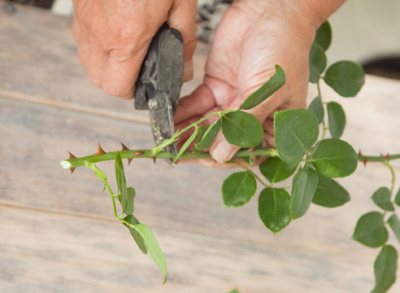

Consider how to grow a sprout. To do this, let's analyze the procedure:
- You need to cut off the stem by five centimeters.
- Wash off excess chemicals.
- Put water in clean room temperature,
- Expose to light. It is best to use special indoor plant lamps.
- Next, check if there are any pests on the rose. Most often it is a spider mite. Take a close look at the fallen leaves: if the reverse side is covered with a dusty layer, and there are cobwebs between the branches of the rose, then an insecticide must be urgently used.
Then, when the leaves begin to fall off, check for small shoots on the stems. It is them that you will use for planting.
Almost every woman loves beautiful roses, but not everyone knows what to do to keep cut roses in the vase longer and why they quickly wither, what to add to the water when it is necessary to reanimate and how to save flowers if they start to wither.
How to properly transplant a room rose after purchase
Indoor roses that we buy in pots often grow in clear peat or other light, loose litter that has no nutrients at all. Manufacturers of such plants, in order to give these miniature roses a more marketable appearance, when growing, feed them with a special solution, the composition of which is kept secret.If you leave miniature roses, like other indoor flowers, in the same soil and start watering it with plain water, then the peat quickly sours and this causes a fungal infection (twigs turn black), and the plant quickly dies.
Transplanting indoor roses After purchasing a potted rose, it is imperative to transplant it. But not on the same day, but to give her some time to get used to the new conditions. Immediately after purchasing the rose, be sure to wash it with warm water and soap. This can be done by simply dipping it headlong into a bowl of water for 20-30 minutes. Then arrange a contrast shower for her - alternate hot water (40 degrees) with warm water. After that, sprinkle it abundantly with water with the addition of epin (5 drops per liter of water) and pour it well with the same solution, let the water drain and build a "greenhouse" for the rose from a bag stretched over sticks stuck into the ground.
The main thing is that the bag does not touch the leaves. It is necessary to air the rose daily, increasing the airing time every day. Once the flowers start to fade, remove ALL of them. Then carefully remove the plants (usually several roses in one pot) from the pot. Immerse the roots in warm boiled water and very carefully wash off ALL the soil from the roots.
Roots can often be found underground wrapped in nonwoven fabric. This canvas must be removed, trying to injure the roots as little as possible. It is necessary to rinse in order to completely remove the transport soil with chemicals, which are introduced specifically so that the rose remains miniature, does not grow, and the flowers do not crumble for a long time. After rinsing the roots, each plant must be planted in an individual pot.
Do not transplant the rose into an oversized pot. From this, it may begin to bloom worse. The new pot should be about 5 cm in height and 3-5 cm in diameter larger than the old one. The soil should be loose, moisture-absorbing, with a neutral or slightly acidic reaction. It is better to buy special earth for roses in a flower shop. The pot should have drainage holes and 1 cm of fine expanded clay should be poured onto the bottom of the pot for good drainage. It is necessary to plant roses at the same depth at which they sat in the previous pot. After transplanting, place the rose on a north window or in a shaded area for one to two days. And for a permanent residence of a rose, you need to choose a window in the south or southeast. In winter, it is advisable to provide the rose with additional lighting with a fluorescent lamp for up to 14-15 hours a day.
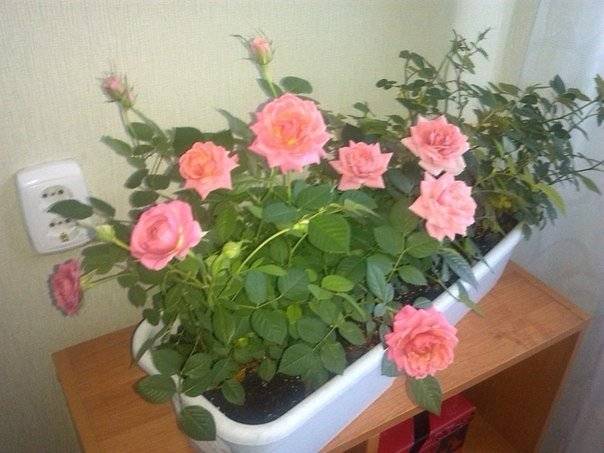

A wonderful trio: corn, peas and pumpkin. The American Indians knew the secret of their joint cultivation. Corn will provide support. Further
Rose sprout in a vase how to plant
Seedling care rules
Fertilizer will be required for seedlings that have grown more than 12 cm. For this, complex solutions or infusion of herbs, mullein are used. For the plant to be strong, in the first year, you must immediately cut the flower buds after they appear. This will allow the rosebush to put all its energy into forming healthy stems.
In advance, you need to take care of the shelter of the plant for the autumn-winter period. This will save the bushes from frost. Some specimens should be excavated and stored in a cool, damp place. So roses from a bouquet will appear in the garden again and again, delighting not only the gardener, but everyone around them.
In advance, you need to take care of the shelter of the plant for the autumn-winter period. This will save the bushes from frost. Some specimens should be excavated and stored in a cool, damp place. So roses from a bouquet will appear in the garden again and again, delighting not only the gardener, but everyone around them.
Growing problems
When growing roses from cuttings, there may be some problems that need attention and quick fix.
The sprouts grow and dry up
Young plants are sensitive to sudden changes in temperature and low or very high air humidity.
In a room with warm, dry air, after removing the shelter, they actively begin to grow. Young shoots with leaves appear. Underdeveloped roots are not able to feed them. And after 1-1.5 months, the cuttings die.
To correct the problem, removing the shelter should not be done immediately, but gradually accustoming the plants to a different temperature. The air must be humidified daily using a spray bottle or humidifier. For additional nutrition, plants are fertilized with mineral fertilizers.
Do not take root
An unrooted stalk at first consumes its entire supply of nutrients to bloom the buds. When the stock ends, and the roots have not appeared, then the death of the plant occurs. The leaves turn yellow, the stalk dies.
For the successful rooting of rose cuttings, 5 conditions must be met:
- Use of root growth stimulants;
- Air temperature - 23-25 degrees;
- Moist, porous, breathable soil;
- Wet air;
- Adequate amount of light.
Compliance with these conditions allows you to maximize your chances of rooting.
Cuttings turn black
If individual cuttings have turned black and dried, then this is a natural waste of plants. If a large number of cuttings are missing, then you need to understand the reasons.
Most often, they turn black due to various diseases and unfavorable conditions of detention. This is due to high or low humidity, poor lighting, lack of ventilation and thickening of the plantings.
The ground temperature should not drop to 17 degrees at night and 19 degrees during the day. A decrease in these indicators leads to the death of cuttings.
Fungus may be the cause of the blackening. At high humidity, it spreads through the plant very quickly. To reduce the risk of injury, during rooting, the soil is preliminarily spilled with a solution of potassium permanganate and calcined in the oven. The earth should be light, loose. You can add perlite or vermiculite to it.
To prevent the stalk from rotting, a recess is made in the center of the pot (poured soil), washed sand is poured into it, and the stalk is installed in it. It should not touch the bottom cut of the ground, but be in the sand.
Also, bacterial cancer can be the cause of blackening. With the disease, rounded brown spots appear on the leaves and stem. Over time, they die off, black-brown ulcers are formed. Affected plants dry out over time. Infected roses must be removed and burned immediately.
Blackened rose leaves can also indicate black spot. Purple-white spots appear on the top of the leaves, on which, after a while, black spores of the fungus appear. The spots swell, become dark. The leaves darken, turn brown, curl, fall off.
Rooting shoots in water
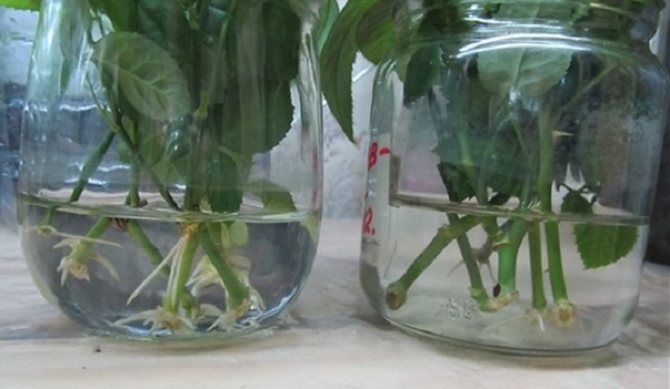

We place the finished cuttings in a jar of water and wait for the roots to form. The process is quite lengthy. Water must be changed regularly, every three to four days, so that it does not stagnate. It should be warm, settled. Crushed charcoal is added to it for disinfection. The jar with shoots should be kept in a shaded, quiet place at temperatures up to 25 degrees. With this method, the roots appear in three to four weeks. After the roses have sprouted, plant them in open ground or pots and cover with a plastic bottle. Do not forget to regularly water the flower until it is completely rooted.
This method is less effective than the previous ones. This is due to the fact that the plant lacks oxygen in the water.
How to care for the planted processes
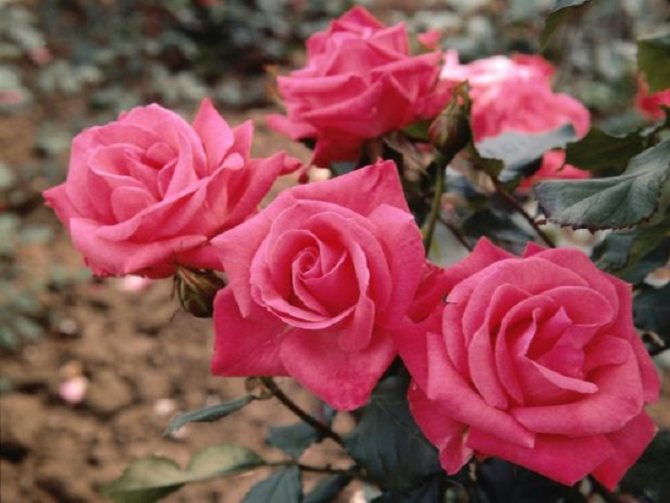

Caring for rose branches does not require any special measures. It is necessary to periodically loosen the ground around the plant. This will provide air access to its underground part. Watering in hot and dry weather should be frequent, but do not fill, as the roots can rot
Top dressing can be done with organic fertilizers, such as rotted manure or compost.In addition to feeding the plant, they will keep moisture in the ground from evaporation.

